1. Mausoleum del Che Guevara
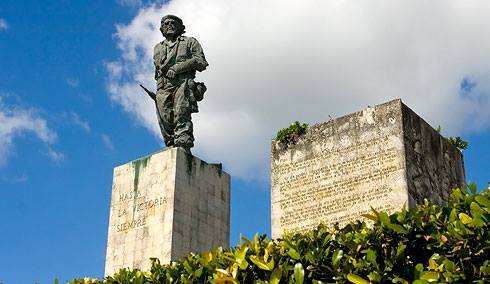
The end point of many a Che pilgrimage, this monument, mausoleum and museum complex is 2km west of Parque Vidal (via Rafael Trist?? on Av de los Desfiles), near the V??azul bus station. Even if you can’t stand the Argentine guerrilla for whom many reserve an almost religious reverence, there’s poignancy in the vast square that spans both sides of the carretera , guarded by a bronze statue of El Che.
The statue was erected in 1987 to mark the 20th anniversary of Guevara’s murder in Bolivia, and can be viewed any time. Accessed from the statue’s rear, the respectful mausoleum contains 38 stone-carved niches dedicated to the other guerrillas killed in the failed Bolivian revolution. In 1997 the remains of 17 of them, including Guevara, were recovered from a secret mass grave in Bolivia and reburied in this memorial. Fidel Castro lit the eternal flame on October 17, 1997. The adjacent museum houses the details and ephemera of Che’s life and death.
2. Parque Vidal
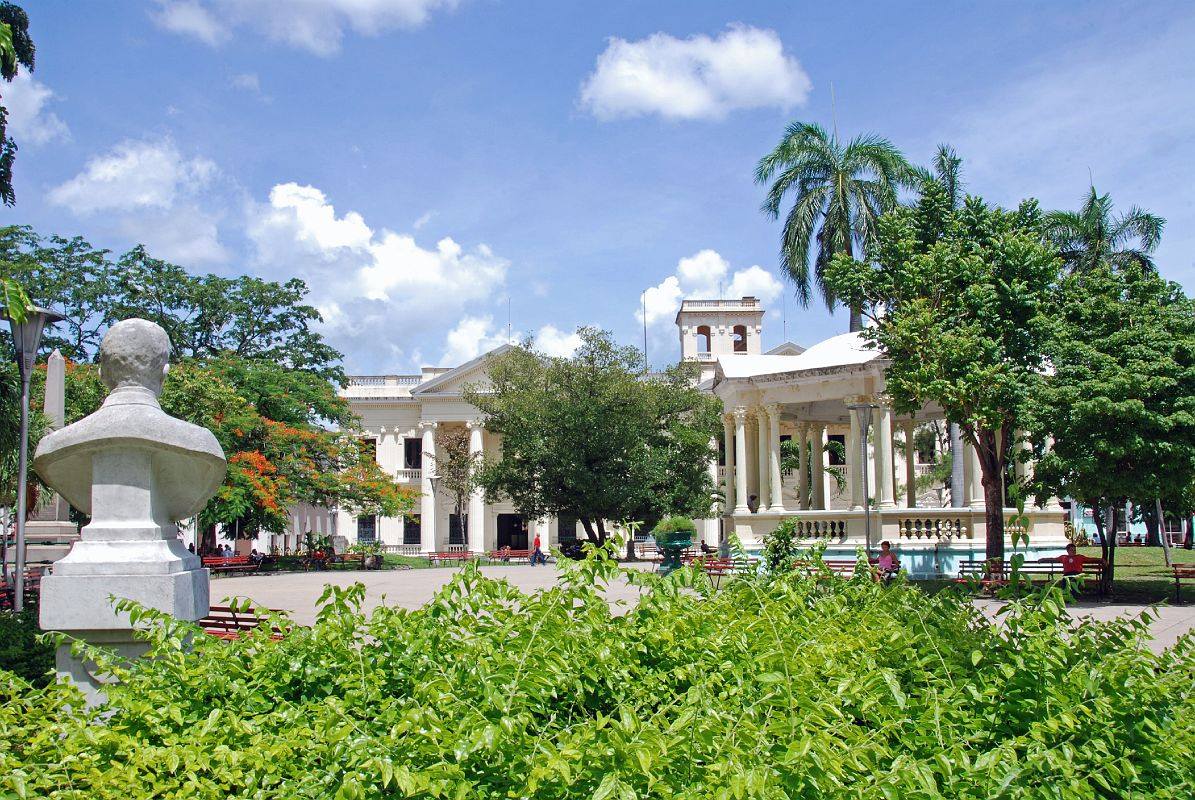
A veritable alfresco theater named for Colonel Leoncio Vidal y Caro, who was killed here on March 23, 1896, Parque Vidal was encircled by twin sidewalks during the colonial era, with a fence separating blacks and whites. Scars of more recent division are evident on the facade of mint-green Hotel Santa Clara Libre on the park’s west side: it’s pockmarked by bullet holes from the 1958 battle for the city between Guevara and Batista’s government troops.
Today all the colors of Cuba’s cultural rainbow mix in one of the nation’s busiest and most vibrant urban spaces, with old men in guayabera shirts gossiping on the shaded benches and young kids getting pulled around in carriages led by goats. Find time to contemplate the statues of local philanthropist Marta Abreu and the emblematic El Ni??o de la Bota (Boy with a Boot), a long-standing city symbol. Since 1902, the municipal orchestra has played rousingly in the park bandstand at 8pm every Thursday and Sunday, whilst classical music is played within the neoclassical Palacio Provincial , flanking the east side of the park.
3. Cayo Santa Mar??a

Cayo Santa Mar??a is a small key, 16 km (10 mi) long by 2 km (1.2 mi) wide, located in the Bahia de Buenavista, off the north coast of the main island of Cuba, in the western part of Jardines del Rey archipelago. CSM is part of a tourist pole of 3 cayos: Cayo Santa Mar??a, Cayo Ensenachos and Cayos Las Brujas (a.k.a Los Cayos de Villa Clara).
CSM is in the Villa Clara province but is located only 30 km (18.6 mi) as-the-crow-flies west from Cayo Guillermo and Cayo Coco, which are two other popular tourist destinations in the nearby province of Ciego de Avila. It??s one of Cuba??s most recently developed tourist poles, the first hotel opened its door late December 2001, there are now 12.??CSM is connected to the main land by a 48 km (30 mi) causeway (called Pedraplen in Spanish). The construction of this dike took 10 years (1989-99). The beaches and hotels are all located along??the northern coastline of Cayo Santa Mar??a, while the south coast is mainly dominated by salt marshes and mangroves.
4. Parrandas de Remedio
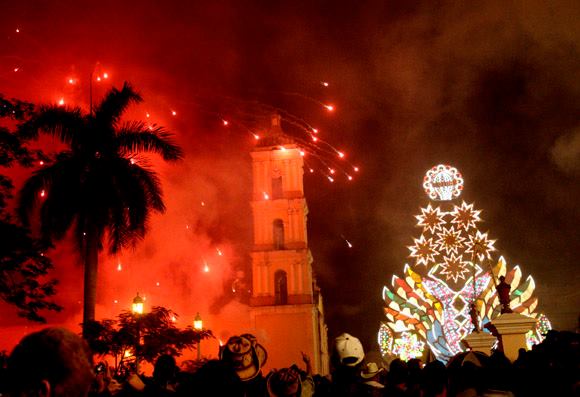
The Cuban town of Remedios was founded around 1514, but it wasn???t until 1578 after a fire that it was given the name of San Juan de los Remedios del Cayo, popularly known as Remedios. This peaceful town has a small, well-preserved historic center around Plaza Mart??. Overlooking the square is the city cathedral, San Juan Bautista, considered one of the most important churches in Cuba. Behind the church is the House of Alejandro Garc??a Caturla, a talented Cuban 20th-century composer, pianist, saxophone player, percussionist, violinist and singer. He was, and still is, a personality within the Cuban culture. His house gathers a comprehensive collection of his personal belongings, musical instruments, and photographs.
However, none of this makes the town as famous as it is. Undoubtedly, what is most renowned about it are the Parrandas Remedianas! This is a festivity based on the competition between the only two quarters of the town: San Salvador and Carmen. The festival has music, dances, and parades with floats (carrozas) and huge wooden contraptions (trabajos de plaza). The Parrandas begin on December 4 with concerts performed by various percussion instruments, and end with a great crescendo on Christmas Eve. The two quarters have to leave the Trabajos de Plaza made during the whole year on the Plaza Mart?? during the festivities so that they are illuminated at nine in the evening. They can have a historical, cultural, architectural, patriotic, or scientific theme. Afterwards, there are lots of fireworks to welcome the floats, which never come before 3 am and move among the crowd. The whole festivity stretches just until 6 am, at which time a board chooses the best quarter. The most prominent aspect of the Parrandas, however, is that absolutely all the residents take part.
Thus, there is a Mueseo de las Parrandas Remedianas in the town that is worth checking out if you???re not able to make it for the actual Parrandas celebration.
5. Club Mejunje

Urban graffiti, children’s theater, transvestites, old crooners belting out boleros, tourists dancing salsa. You’ve heard about ‘something for everyone’, but this is ridiculous. Welcome to Club Mejunje, set in the ruins of an old roofless building given over to sprouting greenery, a local ??? nay, national ??? institution, famous for many things, not least Cuba’s only official drag show (every Saturday night).
Roll in any day of the week and enjoy an unforgettable ‘only in Santa Clara’ moment.
6. Monumento a la toma del tren blindado
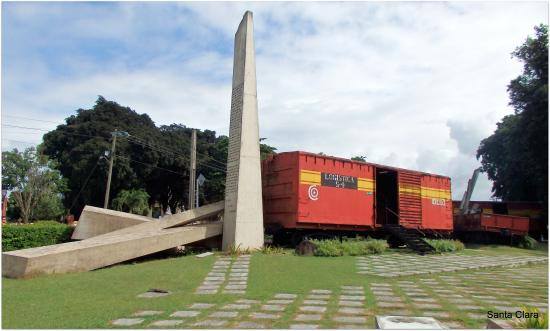
History was made at the site of this small boxcar museum on December 29, 1958, when Ernesto ‘Che’ Guevara and a band of 18 rifle-wielding revolutionaries barely out of their teens derailed an armored train using a borrowed bulldozer and homemade Molotov cocktails.
The battle lasted 90 minutes and improbably pulled the rug out from under the Batista dictatorship, ushering in 50 years of Fidel Castro. The museum ??? east on Independencia, just over the river ??? marks the spot where the train derailed and ejected its 350 heavily-armed government troops. The celebrated bulldozer is mounted on its own plinth at the entrance.
7. F??brica de tabacos Constantino P??rez Carrodegua
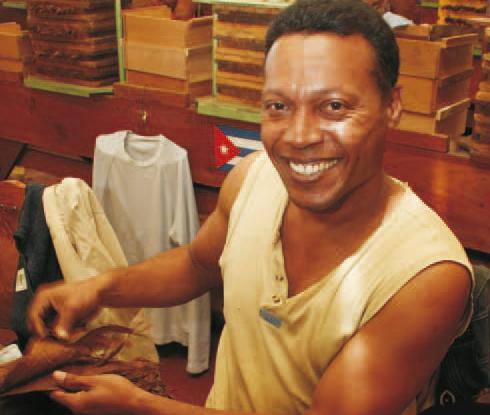
Santa Clara’s tobacco factory, one of Cuba’s best, makes a quality range of Montecristos, Partag??s and Romeo y Julieta cigars. Tours here are lo-fi compared to those in Havana, and so the experience is a lot more interesting and less rushed. Book tickets through Cubatur .
Across the street is La Veguita , the factory’s diminutive but comprehensively stocked sales outlet, staffed by a friendly, ultra-professional team of cigar experts. You can buy cheap rum here, and the bar brews exquisite coffee.
March 3, 2005
Top sights in Villa Clara 0
by Carlos Rodriguez • Location Spotlight, Travelers
1. Mausoleum del Che Guevara

The end point of many a Che pilgrimage, this monument, mausoleum and museum complex is 2km west of Parque Vidal (via Rafael Trist?? on Av de los Desfiles), near the V??azul bus station. Even if you can’t stand the Argentine guerrilla for whom many reserve an almost religious reverence, there’s poignancy in the vast square that spans both sides of the carretera , guarded by a bronze statue of El Che.
The statue was erected in 1987 to mark the 20th anniversary of Guevara’s murder in Bolivia, and can be viewed any time. Accessed from the statue’s rear, the respectful mausoleum contains 38 stone-carved niches dedicated to the other guerrillas killed in the failed Bolivian revolution. In 1997 the remains of 17 of them, including Guevara, were recovered from a secret mass grave in Bolivia and reburied in this memorial. Fidel Castro lit the eternal flame on October 17, 1997. The adjacent museum houses the details and ephemera of Che’s life and death.
2. Parque Vidal

A veritable alfresco theater named for Colonel Leoncio Vidal y Caro, who was killed here on March 23, 1896, Parque Vidal was encircled by twin sidewalks during the colonial era, with a fence separating blacks and whites. Scars of more recent division are evident on the facade of mint-green Hotel Santa Clara Libre on the park’s west side: it’s pockmarked by bullet holes from the 1958 battle for the city between Guevara and Batista’s government troops.
Today all the colors of Cuba’s cultural rainbow mix in one of the nation’s busiest and most vibrant urban spaces, with old men in guayabera shirts gossiping on the shaded benches and young kids getting pulled around in carriages led by goats. Find time to contemplate the statues of local philanthropist Marta Abreu and the emblematic El Ni??o de la Bota (Boy with a Boot), a long-standing city symbol. Since 1902, the municipal orchestra has played rousingly in the park bandstand at 8pm every Thursday and Sunday, whilst classical music is played within the neoclassical Palacio Provincial , flanking the east side of the park.
3. Cayo Santa Mar??a

Cayo Santa Mar??a is a small key, 16 km (10 mi) long by 2 km (1.2 mi) wide, located in the Bahia de Buenavista, off the north coast of the main island of Cuba, in the western part of Jardines del Rey archipelago. CSM is part of a tourist pole of 3 cayos: Cayo Santa Mar??a, Cayo Ensenachos and Cayos Las Brujas (a.k.a Los Cayos de Villa Clara).
CSM is in the Villa Clara province but is located only 30 km (18.6 mi) as-the-crow-flies west from Cayo Guillermo and Cayo Coco, which are two other popular tourist destinations in the nearby province of Ciego de Avila. It??s one of Cuba??s most recently developed tourist poles, the first hotel opened its door late December 2001, there are now 12.??CSM is connected to the main land by a 48 km (30 mi) causeway (called Pedraplen in Spanish). The construction of this dike took 10 years (1989-99). The beaches and hotels are all located along??the northern coastline of Cayo Santa Mar??a, while the south coast is mainly dominated by salt marshes and mangroves.
4. Parrandas de Remedio

The Cuban town of Remedios was founded around 1514, but it wasn???t until 1578 after a fire that it was given the name of San Juan de los Remedios del Cayo, popularly known as Remedios. This peaceful town has a small, well-preserved historic center around Plaza Mart??. Overlooking the square is the city cathedral, San Juan Bautista, considered one of the most important churches in Cuba. Behind the church is the House of Alejandro Garc??a Caturla, a talented Cuban 20th-century composer, pianist, saxophone player, percussionist, violinist and singer. He was, and still is, a personality within the Cuban culture. His house gathers a comprehensive collection of his personal belongings, musical instruments, and photographs.
However, none of this makes the town as famous as it is. Undoubtedly, what is most renowned about it are the Parrandas Remedianas! This is a festivity based on the competition between the only two quarters of the town: San Salvador and Carmen. The festival has music, dances, and parades with floats (carrozas) and huge wooden contraptions (trabajos de plaza). The Parrandas begin on December 4 with concerts performed by various percussion instruments, and end with a great crescendo on Christmas Eve. The two quarters have to leave the Trabajos de Plaza made during the whole year on the Plaza Mart?? during the festivities so that they are illuminated at nine in the evening. They can have a historical, cultural, architectural, patriotic, or scientific theme. Afterwards, there are lots of fireworks to welcome the floats, which never come before 3 am and move among the crowd. The whole festivity stretches just until 6 am, at which time a board chooses the best quarter. The most prominent aspect of the Parrandas, however, is that absolutely all the residents take part.
Thus, there is a Mueseo de las Parrandas Remedianas in the town that is worth checking out if you???re not able to make it for the actual Parrandas celebration.
5. Club Mejunje

Urban graffiti, children’s theater, transvestites, old crooners belting out boleros, tourists dancing salsa. You’ve heard about ‘something for everyone’, but this is ridiculous. Welcome to Club Mejunje, set in the ruins of an old roofless building given over to sprouting greenery, a local ??? nay, national ??? institution, famous for many things, not least Cuba’s only official drag show (every Saturday night).
Roll in any day of the week and enjoy an unforgettable ‘only in Santa Clara’ moment.
6. Monumento a la toma del tren blindado

History was made at the site of this small boxcar museum on December 29, 1958, when Ernesto ‘Che’ Guevara and a band of 18 rifle-wielding revolutionaries barely out of their teens derailed an armored train using a borrowed bulldozer and homemade Molotov cocktails.
The battle lasted 90 minutes and improbably pulled the rug out from under the Batista dictatorship, ushering in 50 years of Fidel Castro. The museum ??? east on Independencia, just over the river ??? marks the spot where the train derailed and ejected its 350 heavily-armed government troops. The celebrated bulldozer is mounted on its own plinth at the entrance.
7. F??brica de tabacos Constantino P??rez Carrodegua

Santa Clara’s tobacco factory, one of Cuba’s best, makes a quality range of Montecristos, Partag??s and Romeo y Julieta cigars. Tours here are lo-fi compared to those in Havana, and so the experience is a lot more interesting and less rushed. Book tickets through Cubatur .
Across the street is La Veguita , the factory’s diminutive but comprehensively stocked sales outlet, staffed by a friendly, ultra-professional team of cigar experts. You can buy cheap rum here, and the bar brews exquisite coffee.